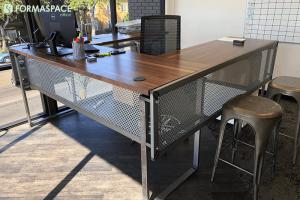HOW ARE TARIFFS & TRADE BARRIERS IMPACTING THE FURNITURE BUSINESS?
Find out how increased tariffs on Chinese imports could change the future of the furniture manufacturing industry forever.
Are we in a trade war?
That’s the billion dollar question that the stock market investors, businesses, and consumers are asking.
The stakes are high as the administration turns to the threat of tariffs as part of its ongoing negotiating strategy to sign new international trade agreements, which they believe are more favorable to American manufacturing and that safeguard American intellectual property (IP).
Actions threatened by Washington against one particular company, the Chinese multi-national electronics and communications giant Huawei, seem to have grabbed all the headlines in recent days – understandably so given the enormous consequences for tech companies, from Apple to Qualcomm, who are facing up to the prospect of having to unwind a truly global supply chain for computer chips and telecommunication components.
U.S. Trade Deficits In The Durable Manufactured Goods
But despite the importance of the electronics industry, it’s not the entire economy, at least not yet.
Given the seriousness of the current and proposed tariffs, we think it’s important to take a look at the balance of trade in durable manufactured goods, then drill down into the effects that tariffs will have on our corner the market: the furniture business.
Where do we stand at the moment with current U.S. trade deficits?
For durable manufactured goods, the picture is not great. Federal agencies report that in 2018, the US imported around $605 billion more durable manufactured goods than we exported. The trend has worsened over the last 5 years: the U.S. net trade deficit in durable manufactured goods has grown by 144% since 2014.
As you can see from the economic data shown in the chart above, we are currently running an account surplus in durable manufactured goods with Canada, Hong Kong, the Netherlands, Australia, and the United Arab Emirates, as well as many other countries shown in green on the map above.
At the other end of the scale are five countries – South Korea, Germany, Japan, Mexico, and China – with whom we have the largest net trading deficits in durable manufactured goods.
Imbalanced trade with China in durable manufactured goods poses a big problem for the US: In 2018, we bought $338 billion more durable manufactured goods from China than we were able to sell to back them – creating a trade deficit that is nearly 10 times the net surplus we have with our best customer, Canada.
The Threat Of Raising Section 301 Tariffs On Chinese Goods From 10% To 25%
The administration in Washington responded to the overseas trade deficit with China by instituting a 10% tariff on many Chinese imports under Section 301 of the Trade Act of 1974. (This was in addition to a tariff on steel and aluminum products, more on that later.)
Then on May 10, 2019, the office of the U.S. Trade Representative announced: “Earlier today, at the direction of the President, the United States increased the level of tariffs from 10 percent to 25 percent on approximately $200 billion worth of Chinese imports. The President also ordered us to begin the process of raising tariffs on essentially all remaining imports from China, which are valued at approximately $300 billion.”
How will this affect our corner of the market, the furniture business?
Fortunately for Formaspace, the direct effects will be minimal. As you probably know, we manufacture all our furniture here in the USA at our Austin, Texas factory headquarters – using locally-supplied raw materials, including domestic steel and wood products.
As a result, Formaspace won’t be directly affected by the new tariffs on imported goods and materials (with the exception of some hardware items, which do come from overseas); however, there may be some indirect effects from these tariffs over the coming months, such as the possibility of increased prices for domestic steel.
But what about other companies that import Chinese furniture products or depend on Chinese raw materials? They could be hit pretty hard.
How hard? Let’s first take a look at the trade balance for imports and exports of U.S. furniture products.
According to Federal trade statistics, the United States is currently running a nearly $40 billion deficit in the overall furniture and fixtures market. Once again, China is racking up the biggest trade deficit, it sold nearly $26 billion more furniture and fixtures to the US in 2018 than we sold back to them. The Chinese imbalance in furniture trade is relatively large compared to that of our other trading partners: e.g. China’s furniture trading deficit is five times larger than that of the next country on the list, Vietnam.
Long-term South African Expat Vlogger Serpentza Provides his Perspective on US-Chinese Trade Relations
What Are The Consequences Of Raising Section 301 Tariffs On Chinese Imported Furniture From 10% To 25%?
Read more...https://formaspace.com/articles/industrial/tariffs-trade-barriers-impacting-furniture-business/?utm_source=einpresswire&utm_medium=content&utm_campaign=article-052719
Mehmet Atesoglu
Formaspace
+5122792792
email us here
Visit us on social media:
Facebook
Twitter
LinkedIn
Legal Disclaimer:
EIN Presswire provides this news content "as is" without warranty of any kind. We do not accept any responsibility or liability for the accuracy, content, images, videos, licenses, completeness, legality, or reliability of the information contained in this article. If you have any complaints or copyright issues related to this article, kindly contact the author above.



